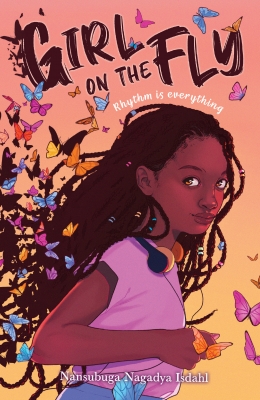Writer Nansubuga Isdahl discusses the importance of centring joy, community and culture in children's books.

Crafting stories that center joy and that bring to life the heart of our human experience is my main motivation for writing children’s books. When I set out to write my debut middle-grade novel, Girl on the Fly, while I didn’t have clear sight on the full narrative arc, I knew I wanted to render the magic of girlhood on the page, along with a particular kind of joy.
The joy of feeling connected to community, or ubuntu.
Ubuntu is a philosophy found across Africa that is rooted in the idea of a universal bond that connects us to one another. The word is most commonly translated as “humanity” or “I am because we are” from Zulu in South Africa. The Zulu phrase from which the word is drawn speaks even more precisely to the idea: “Umuntu ngumuntu ngabantu,” or a person is a person through other people.
Kamaria Kessy, my thirteen-year-old Tanzanian-American protagonist, is passionate about running track and feels a tight sisterhood, akin to ubuntu, with her 4 x 100 relay teammates. Kam believes that if they can just win the upcoming state championship together, their bond will be set in stone. Kam is also someone who struggles with change. When she learns that an aunt from Tanzania, whom she’s never met before, is coming to Philadelphia to stay with her family, a great anxiety takes hold of her. It doesn’t help that she already feels unmoored by an unresolved conflict with her best friend, Odie.
It is from this starting point of competing anxieties, but also precious opportunities to cultivate a deeper sense of joy and togetherness, that readers meet Kam on her journey. Both the emotional richness and the anticipation in the story come from the weaving together of these plotlines. Through the ups and the downs – the nail-biting, high-stakes track competitions, having to adjust to an unfamiliar presence ushered in by Aunt Rose, and mounting tension with Odie – Kam gains a greater understanding of herself, her friends, and her family. She also learns what I believe to be an important truth: feelings of joy and connection can be deepened significantly when they’ve been tried and tested through discomfort.
In Girl on the Fly, when Aunt Rose first arrives, she attempts to connect with Kam by offering her kangas, pieces of cloth worn in East Africa with short Kiswahili sayings or proverbs printed on them. The kangas serve as a bridge between Kam and Aunt Rose and connect Kam to parts of her Tanzanian culture she was unaware of. I was raised on the East Coast of the United States in a family where community was intensely important and long-term house guests from Uganda, where my parents are from, were regular occurrences. I also grew up wearing kangas and I wear them still – in Tanzania where I now live.
Dotting the story with cultural references and taking inspiration from my life allowed me to engage in my own small act of joy during the writing process. It also offered a meaningful way in which to imbue the story with the themes of community, culture, and togetherness.
I hope that as Kam’s story travels through the world, it helps readers of all ages, but especially children, reflect on the role of friendship, family, togetherness and community in their own lives. I hope they can take delight in and learn a bit more about Tanzanian and East African culture. And, while wholly outside of my control, I do hope readers can walk away from this story with some small sense that it was drawn from a place of joy. Because it was.
Nansubuga Isdahl is a writer and editor. Her recent books include BEYONCÉ (Knowles-Carter) and NELSON (Mandela), in DFB’s First Names series of illustrated biographies. Nansubuga has also worked on international development programmes, primarily in East and Southern Africa, for over a decade. Her clients include the World Bank, World Education, UNICEF and UNESCO.
Comments